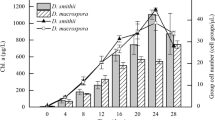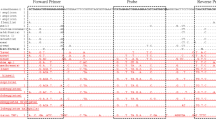Abstract
Vampirovibrio chlorellavorus is an obligate, predatory bacterial pathogen of the genus Chlorella. It is recognized as an important pathogen of Chlorella sorokiniana, field isolate DOE 1412, a highly-favored microalga for cultivation in outdoor reactors in the arid USA Southwest for feedstocks used in biofuel production. To determine the V. chlorellavorus titer, based on gene copy number, required to cause infection and mortality of C. sorokiniana in an experimental outdoor reactor, a multiplexed quantitative polymerase chain reaction (qPCR) assay was developed for pathogen detection, based on the 16S and 18S ribosomal RNA gene of V. chlorellavorus and C. sorokiniana, respectively. The assay was further used to establish the optimal effective concentration of benzalkonium chloride required to achieve a below “disease-threshold”-bacterial titer, while minimizing biocidal effects on algal growth and enable economic biomass production. Reactors treated with 2.0 ppm benzalkonium chloride at four-day intervals throughout the cultivation cycle experienced runs of 22 days or longer, compared to 12 days for the untreated control. The qPCR assay was used to estimate disease severity over time using the Area Under the Disease Progress Stairs (AUDPS) metric, indicating a severity rating of 0.016 and 62.308 in biocide-treated and untreated cultures, respectively. The near-real time assay detected as few as 13 copies of V. chlorellavorus, allowing for the recognition of its presence in the reactor just before algal cell density decreased, an indication of pathogen attack, while also informing the timing of biocide applications to minimize DOE 1412 infection such that harvestable biomass could be produced.






Similar content being viewed by others
References
Amann RI, Ludwig W, Schleifer KH (1995) Phylogenetic identification and in situ detection of individual microbial cells without cultivation. Microbiol Rev 59:143–169
Amer L, Adhikari B, Pellegrino J (2011) Technoeconomic analysis of five microalgae-to-biofuels processes of varying complexity. Bioresour Technol 102:9350–9359
Armbruster DA, Pry T (2008) Limit of blank, limit of detection and limit of quantitation. Clin Biochem Rev 29:S49–S52
Benson DA, Cavanaugh M, Clark K, Karsch-Mizrachi I, Lipman DJ, Ostell J, Sayers EW (2013) GenBank. Nucleic Acids Res 41:D36–D42
Burrows SM, Elbert W, Lawrence MG, Pöschl U (2009) Bacteria in the global atmosphere–part 1: review and synthesis of literature data for different ecosystems. Atmos Chem Phys 9:9263–9280
Camacho C, Coulouris G, Avagyan V, Ma N, Papadopoulos J, Bealer K, Madden TL (2009) BLAST+: architecture and applications. BMC Bioinformatics 10:421
Coder DM, Goff LJ (1986) The host range of the chlorellavorous bacterium (“Vampirovibrio chlorellavorus”). J Phycol 22:543–546
Coder DM, Starr MP (1978) Antagonistic association of the chlorellavorus bacterium (“Bdellovibrio” chlorellavorus) with Chlorella vulgaris. Curr Microbiol 1:59–64
Cole JR, Chai B, Farris RJ, Wang Q, Kulam SA, McGarrell DM, Garrity GM, Tiedje JM (2005) The ribosomal database project (RDP-II): sequences and tools for high-throughput rRNA analysis. Nucleic Acids Res 33:D294–D296
Crowe B, Attalah S, Agrawal S, Waller P, Ryan R, Van Wagenen J, Chavis A, Kyndt J, Kacira M, Ogden KL et al (2012) A comparison of Nannochloropsis salina growth performance in two outdoor pond designs: conventional raceways versus the arid pond with superior temperature management. Int J Chem Eng 2012:1–9
Daugbjerg N, Hansen G, Larsen J, Moestrup Ø (2000) Phylogeny of some of the major genera of dinoflagellates based on ultrastructure and partial LSU rDNA sequence data, including the erection of three new genera of unarmoured dinoflagellates. Phycologia 39:302–317
De Mendiburu F (2014) Agricolae: statistical procedures for agricultural research. R package version 1.1–6. https://CRAN.R-project.org/package=agricolae
Doyle J, Doyle JL (1990) Isolation of plant DNA from fresh tissue. FOCUS 12:13–15
Duffy T, Cura CI, Ramirez JC, Abate T, Cayo NM, Parrado R, Bello ZD, Velazquez E, Muñoz-Calderon A, Juiz NA, Basile J, Garcia L, Riarte A, Nasser JR, Ocampo SB, Yadon ZE, Torrico F, de Noya BA, Ribeiro I, Schijman AG (2013) Analytical performance of a multiplex real-time PCR assay using TaqMan probes for quantification of Trypanosoma cruzi satellite DNA in blood samples. PLoS Negl Trop Dis 7:e2000
Fry WE (1978) Quantification of general resistance of potato cultivars and fungicide effects for integrated control of potato late blight. Phytopathology 68:1650
Ganuza E, Sellers CE, Bennett BW, Lyons EM, Carney LT (2016) A novel treatment protects Chlorella at commercial scale from the predatory bacterium Vampirovibrio chlorellavorus. Front Microbiol 7:848
Green M, Sambrook J (2012) Molecular cloning: A laboratory manual (fourth edition): three volume set. Cold Spring Harbor Press, Cold Spring Harbor
Gromov BV, Mamkaeva KA (1972) Electron microscopic study of parasitism by Bdellovibrio chlorellavorus bacteria on cells of the green alga Chlorella vulgaris. Tsitologiia 14:256–260
Hou Y, Zhang H, Miranda L, Lin S (2010) Serious overestimation in quantitative PCR by circular (supercoiled) plasmid standard: microalgal pcna as the model gene. PLoS One 5:e9545
Houari A, Di Martino P (2007) Effect of chlorhexidine and benzalkonium chloride on bacterial biofilm formation. Lett Appl Microbiol 45:652–656
Hu Q, Sommerfeld M, Jarvis E, Ghirardi M, Posewitz M, Seibert M, Darzins A (2008) Microalgal triacylglycerols as feedstocks for biofuel production: perspectives and advances. Plant J 54:621–639
Huesemann MH, Van Wagenen J, Miller T, Chavis A, Hobbs S, Crowe B (2013) A screening model to predict microalgae biomass growth in photobioreactors and raceway ponds. Biotechnol Bioeng 110:1583–1594
Huesemann M, Crowe B, Waller P, Chavis A, Hobbs S, Edmundson S, Wigmosta M (2016) A validated model to predict microalgae growth in outdoor pond cultures subjected to fluctuating light intensities and water temperatures. Algal Res 13:195–206
Jean MDS, Brignole F, Bringuier AF, Bauchet A, Feldmann G, Baudouin C (1999) Effects of benzalkonium chloride on growth and survival of Chang conjunctival cells. Invest Ophthalmol Vis Sci 40:619–630
Jorquera O, Kiperstok A, Sales EA, Embiruçu M, Ghirardi ML (2010) Comparative energy life-cycle analyses of microalgal biomass production in open ponds and photobioreactors. Bioresour Technol 101:1406–1413
Klindworth A, Pruesse E, Schweer T, Peplies J, Quast C, Horn M, Glöckner FO (2013) Evaluation of general 16S ribosomal RNA gene PCR primers for classical and next-generation sequencing-based diversity studies. Nucleic Acids Res 41:e1–e1
Lammers PJ, Huesemann M, Boeing W, Anderson DB, Arnold RG, Bai X, Bhole M, Brhanavan Y, Brown L, Brown J, Brown JK, Chisholm S, Meghan Downes C, Fulbright S, Ge Y, Holladay JE, Ketheesan B, Khopkar A, Koushik A, Laur P, Marrone BL, Mott JB, Nirmalakhandan N, Ogden KL, Parsons RL, Polle J, Ryan RD, Samocha T, Sayre RT, Seger M, Selvaratnam T, Sui R, Thomasson A, Unc A, van Voorhies W, Waller P, Yao Y, Olivares JA (2017) Review of the cultivation program within the National Alliance for Advanced Biofuels and Bioproducts. Algal Res 22:166–186
Lindow SE (1983) Estimating disease severity of single plants. Phytopathology 73:1576–1581
Malic S, Hill KE, Hayes A, Percival SL, Thomas DW, Williams DW (2009) Detection and identification of specific bacteria in wound biofilms using peptide nucleic acid fluorescent in situ hybridization (PNA FISH). Microbiology 155:2603–2611
Marchesi JR, Sato T, Weightman AJ, Martin TA, Fry JC, Hiom SJ, Wade WG (1998) Design and evaluation of useful bacterium-specific PCR primers that amplify genes coding for bacterial 16S rRNA. Appl Environ Microbiol 64:795–799
Matsuki T, Watanabe K, Tanaka R, Fukuda M, Oyaizu H (1999) Distribution of bifidobacterial species in human intestinal microflora examined with 16S rRNA-gene-targeted species-specific primers. Appl Environ Microbiol 65:4506–4512
McBride RC, Lopez S, Meenach C, Burnett M, Lee PA, Nohilly F, Behnke C (2014) Contamination management in low cost open algae ponds for biofuels production. Ind Biotechnol 10:221–227
Metting FB (1996) Biodiversity and application of microalgae. J Ind Microbiol Biotechnol 17:477–489
Park SH, Steichen SA, Li X, Ogden KL, Brown JK (2018) Association of Vampirovibrio chlorellavorus with decline and death of Chlorella sorokiniana in outdoor reactors. J Appl Phycol. https://doi.org/10.1007/s10811-018-1633-9
Paulson DS (2002) Handbook of topical antimicrobials: industrial applications in consumer products and pharmaceuticals. CRC Press, Boca Raton
Pedroni PM, Lamenti G, Prosperi G, Ritorto L, Scolla G, Capuano F, Valdiserri M (2004) EniTecnologie R&D project on microalgae biofixation of CO2: outdoor comparative tests of biomass productivity using flue gas CO2 from a NGCC power plant. Enrgy Proced 2:1037–1042
R Core Team (2013) R: a language and environment for statistical computing. R Foundation for Statistical Computing, Vienna
Rinttila T, Kassinen A, Malinen E, Krogius L, Palva A (2004) Development of an extensive set of 16S rDNA-targeted primers for quantification of pathogenic and indigenous bacteria in faecal samples by real-time PCR. J Appl Microbiol 97:1166–1177
Rippka R, Herdman M (1993) Pasteur culture collection of cyanobacterial strains in axenic culture, catalogue of strains 1992/1993. Pasteur Institute, Paris
Rozen S, Skaletsky H (2000) Primer3 on the WWW for general users and for biologist programmers. In: Misener S, Krawetz SA (eds) Bioinformatics methods and protocols. Meth Molec Biol 132. Humana Press, Totowa
Saiki RK, Gelfand DH, Stoffel S, Scharf SJ, Higuchi R, Horn GT, Mullis KB, Erlich HA (1988) Primer-directed enzymatic amplification of DNA with a thermostable DNA polymerase. Science 239:487–491
Simko I, Piepho H-P (2012) The area under the disease progress stairs: calculation, advantage, and application. Phytopathology 102:381–389
Soo RM, Skennerton CT, Sekiguchi Y, Imelfort M, Paech SJ, Dennis PG, Steen JA, Parks DH, Tyson GW, Hugenholtz P (2014) An expanded genomic representation of the phylum cyanobacteria. Genome Biol Evol 6:1031–1045
Soo RM, Woodcroft BJ, Parks DH, Tyson GW, Hugenholtz P (2015) Back from the dead; the curious tale of the predatory cyanobacterium Vampirovibrio chlorellavorus. PeerJ 3:e968
Stewart EJ (2012) Growing unculturable bacteria. J Bacteriol 194:4151–4160
Taylor S, Wakem M, Dijkman G, Alsarraj M, Nguyen M (2010) A practical approach to RT-qPCR—publishing data that conform to the MIQE guidelines. Methods 50:S1–S5
Varon M, Shil M (1968) Interaction of Bdellovibrio bacteriovorus and host bacteria. I Kinetic studies of attachment and invasion of Escherichia coli B by Bdellovibrio bacteriovorus. J Bacteriol 95:744–753
Voth DE, Broederdorf LJ, Graham JG (2012) Bacterial Type IV secretion systems: versatile virulence machines. Future Microbiol 7:241–257
Wallden K, Rivera-Calzada A, Waksman G (2010) Microreview: Type IV secretion systems: versatility and diversity in function. Cell Microbiol 12:1203–1212
Waller P, Ryan R, Kacira M, Li P (2012) The algae raceway integrated design for optimal temperature management. Biomass Bioenergy 46:702–709
Weisburg WG, Barns SM, Pelletier DA, Lane DJ (1991) 16S ribosomal DNA amplification for phylogenetic study. J Bacteriol 173:697–703
Zhu F, Massana R, Not F, Marie D, Vaulot D (2005) Mapping of picoeucaryotes in marine ecosystems with quantitative PCR of the 18S rRNA gene. FEMS Microbiol Ecol 52:79–92
Acknowledgements
The authors would like to express appreciation to Caitlin C. Brown and Noel Kitchen for their support and invaluable contributions with culture maintenance and qPCR assay design and validation, to undergraduates Cassandra Galves and Stephen Lee for laboratory assistance, and to the ARID raceway team. The first author would like to thank Drs. J.K. Brown and K. Ogden for guidance and mentoring throughout this study, leading to completion of his Master’s Thesis.
Funding
Support for this research was provided from the Department of Energy Grant DE-EE0006269.
Author information
Authors and Affiliations
Corresponding author
Ethics declarations
Conflict of interest statement
The authors declare they have no conflicts of interest.
Electronic supplementary material
Supplemental Fig. 1
Benzalkonium chloride effects on DOE 1412 growth and Vampirovibrio chlorellavorus accumulation in field reactors. Growth data of experiments conducted from May 19 to Jun 9, 2016 reporting Top) culture temperature is displayed as recorded by continuous data logger from PW1 reactor unit and compared across a time course of 25 days of growth against Middle) the optical density (absorbance at 750 nm) of Chlorella sorokiniana culture in collocated PW reactor units either treated with BAC or a no treatment control (NT) as well as rain fill, quantified by the volume of water added to reactors. Bottom) V. chlorellavorus accumulation is displayed in both biomass and supernatant fractions by the ratio of 16S ribosomal RNA gene per algal cell 18S ribosomal RNA gene detected on a logarithmic scale which excludes initial time point samples of undetected 16S ribosomal RNA genes. (PDF 62 kb)
Rights and permissions
About this article
Cite this article
Steichen, S.A., Brown, J.K. Real-time quantitative detection of Vampirovibrio chlorellavorus, an obligate bacterial pathogen of Chlorella sorokiniana. J Appl Phycol 31, 1117–1129 (2019). https://doi.org/10.1007/s10811-018-1659-z
Received:
Revised:
Accepted:
Published:
Issue Date:
DOI: https://doi.org/10.1007/s10811-018-1659-z




